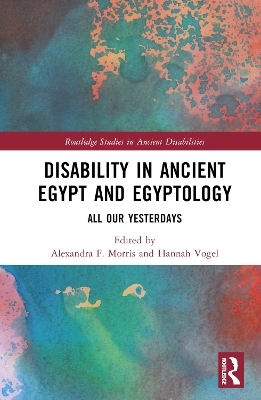
Disability in Ancient Egypt and Egyptology
Routledge (Verlag)
978-1-032-57648-0 (ISBN)
- Lieferbar (Termin unbekannt)
- Versandkostenfrei innerhalb Deutschlands
- Auch auf Rechnung
- Verfügbarkeit in der Filiale vor Ort prüfen
- Artikel merken
Through a critical investigation, this volume reshapes often-overlooked narratives of disability within the discipline of Egyptology and Egyptian Archaeology. Chapters explore evidence of disability, the historiographical ways in which disability has been approached, and how disability histories are (mis)represented in various contemporary spaces. Coverage stretches across Egypt and Nubia from the Predynastic to the Roman periods, as well as receptions of these cultures and disability in museums. Its editors and many of its authors are disability community members who are experts in their respective professions, comprising an international authorship and including voices from typically underrepresented groups. Contributors range from early career researchers to senior scholars, as well as those working outside of and adjacent to academia. While focusing on ancient Egypt and Egyptology, this volume offers new ways to consider disability in the broadest possible sense. It uses terminology informed by the disability community and offers guidance for disability inclusivity in curatorial and pedagogical museum and university contexts. It prioritises disability as an essential area of research in ancient world studies, and platforms both ancient and modern disabled voices. The deep, detailed exploration into disability in the past and in our discipline offered by this book inspires readers to further explore and appreciate the infinite diversity of the human experience in all its infinite combinations.
The first-book length treatment of the subject, Disability in Ancient Egypt and Egyptology provides a much-needed resource for students and scholars of ancient Egypt, Egyptology, and disability in the ancient world. It is also suitable for researchers in Disability Studies, practitioners in broader ancient world studies, and museum and heritage professionals.
Chapter 1 of this book is freely available as a downloadable Open Access PDF at http://www.taylorfrancis.com under a Creative Commons Attribution-Non Commercial-No Derivatives 4.0 license.
Alexandra F. Morris is a disabled Egyptologist, lecturer, and disability activist. Her research is on disability in ancient Egypt, the Classical world, and creating inclusive museums. She holds many roles in academic, disability, heritage, and government sectors. She has cerebral palsy and dyspraxia. Hannah Vogel is an archaeologist researching ableism and disability in the ancient world and the disciplines of history and archaeology. Her research interests include disability studies, bioarchaeology, and Egyptology. She is an advocate for accessibility and has worked in museums, public outreach, and inclusive pedagogies.
Introduction; Theme One: Disability in Egyptology: Reception Studies, Museums, and Pedagogy; 1. Disability Studies: An Introduction for Egyptology - Hannah Vogel; 2. Challenging the eugenic paradigm in Egyptology - Lucas Justinian; 3.The Measure of a Man: Akhenaten, Tutankhamun, and the (Pseudo)science of Disability in Egyptology- Alexandra F. Morris and Kyle Lewis Jordan; 4. Grande Morbidezza: The Invention of Akhenaten’s Illness - Steven M. Stannish; 5 Jaroslav Černý: working with disabilities in Egyptology, 1942–1970 - Hana Navratilova; 6. Overlooked but on Display: Disability and Human Remains in the British Museum- Roisin Mackie; 7. Accessibility and Disability Representation in Ancient Egyptian Exhibits: Considerations for Planning a Classroom Field Trip - Karen L. Kobylarz; Theme Two: Disability in Ancient Egypt and Nubia; 8. What was the Occupation of Disabled People in Ancient Egypt?- Samar Mostafa Kamal; 9. People with Spinal Curvatures of the Nile Valley. Presence, perception & solidarity from Nagada to the Middle Kingdom- Bénédicte Lhoyer; 10. Defining the Idealized Body: A Reexamination of Depictions of Dwarfism in Old Kingdom Art- Emily Smith-Sangster; 11. Bes or the offense of physiognomy in Egyptology- Livia Bergerot; 12. Dwarfism in Ancient Egypt/Nubia: Utilising the Bioarchaeology of Care Approach to Investigate Léri-Weill Dyschondrosteosis- Katie M. Whitmore and Michele R. Buzon; 13. Talipes cavus in Mummified Egyptian Human Remains- Michael R. Zimmerman; 14. Siptah’s Leg and Other Stories- Aidan Dodson; 15. And the Children Shall Lead: Harpocrates, Harpocratis and Cerebral Palsy - Alexandra F. Morris; 16. On deafness in ancient Egyptian literary and para-literary texts - Ilaria Cariddi; 17. Impairments as Biometric Modalities in Graeco-Roman Papyri, 241 BCE–299 CE - Ella Karev; 18. Disability in the Greek papyri from Roman Egypt: a public concern? - Nicola Reggiani; 19. “Go Away Baldy”: Two Cross-Cultural Tales of Baldness - Rosalind Janssen; 20. Archaeology of genital mutilation: Disabled masculinity of Libyan enemies in the Egyptian New Kingdom - Uroš Matić; 21. DisAbility, Eunuchs and the Lived Experience in Ptolemaic-Roman Egypt - Sonia R Zakrzewski, Stephanie Evelyn-Wright and Scott Haddow.
| Erscheinungsdatum | 18.12.2024 |
|---|---|
| Reihe/Serie | Routledge Studies in Ancient Disabilities |
| Zusatzinfo | 16 Tables, black and white; 32 Halftones, black and white; 32 Illustrations, black and white |
| Verlagsort | London |
| Sprache | englisch |
| Maße | 156 x 234 mm |
| Gewicht | 830 g |
| Themenwelt | Geisteswissenschaften ► Archäologie |
| Geschichte ► Allgemeine Geschichte ► Vor- und Frühgeschichte | |
| Geschichte ► Allgemeine Geschichte ► Altertum / Antike | |
| Studium ► Querschnittsbereiche ► Geschichte / Ethik der Medizin | |
| ISBN-10 | 1-032-57648-0 / 1032576480 |
| ISBN-13 | 978-1-032-57648-0 / 9781032576480 |
| Zustand | Neuware |
| Informationen gemäß Produktsicherheitsverordnung (GPSR) | |
| Haben Sie eine Frage zum Produkt? |
aus dem Bereich


